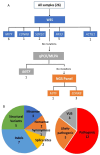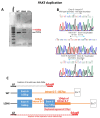Waardenburg Syndrome: The Contribution of Next-Generation Sequencing to the Identification of Novel Causative Variants
- PMID: 38391765
- PMCID: PMC10886116
- DOI: 10.3390/audiolres14010002
Waardenburg Syndrome: The Contribution of Next-Generation Sequencing to the Identification of Novel Causative Variants
Abstract
Waardenburg syndrome (WS) is characterized by hearing loss and pigmentary abnormalities of the eyes, hair, and skin. The condition is genetically heterogeneous, and is classified into four clinical types differentiated by the presence of dystopia canthorum in type 1 and its absence in type 2. Additionally, limb musculoskeletal abnormalities and Hirschsprung disease differentiate types 3 and 4, respectively. Genes PAX3, MITF, SOX10, KITLG, EDNRB, and EDN3 are already known to be associated with WS. In WS, a certain degree of molecularly undetected patients remains, especially in type 2. This study aims to pinpoint causative variants using different NGS approaches in a cohort of 26 Brazilian probands with possible/probable diagnosis of WS1 (8) or WS2 (18). DNA from the patients was first analyzed by exome sequencing. Seven of these families were submitted to trio analysis. For inconclusive cases, we applied a targeted NGS panel targeting WS/neurocristopathies genes. Causative variants were detected in 20 of the 26 probands analyzed, these being five in PAX3, eight in MITF, two in SOX10, four in EDNRB, and one in ACTG1 (type 2 Baraitser-Winter syndrome, BWS2). In conclusion, in our cohort of patients, the detection rate of the causative variant was 77%, confirming the superior detection power of NGS in genetically heterogeneous diseases.
Keywords: NGS; Waardenburg syndrome; neurocristopathy.
Conflict of interest statement
The authors declare no conflict of interest.
Figures



References
-
- Jones M.C. The Neurocristopathies: Reinterpretation Based Upon the Mechanism of Abnormal Morphogenesis. Cleft Palate J. 1990;27:136–140. - PubMed
-
- Farrer L.A., Grundfast K.M., Amos J., Arnos K.S., Asher J.H., Beighton P., Diehl S.R., Fex J., Foy C., Friedman T.B. Waardenberg syndrome (WS) type I is caused by defects at multiple loci, one of which is near ALPP on chromosome 2: First report of the WS consortium. Am. J. Hum. Genet. 1992;50:902–913. - PMC - PubMed
Grants and funding
LinkOut - more resources
Full Text Sources

